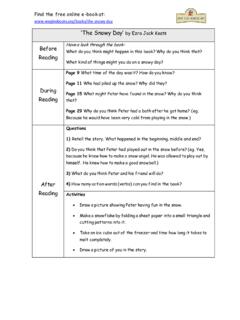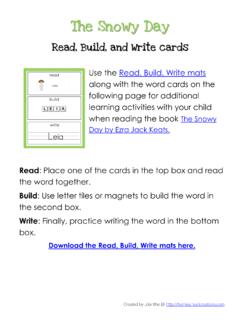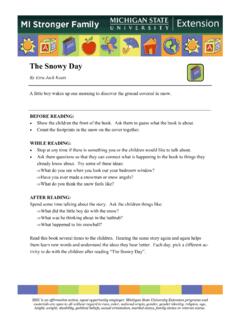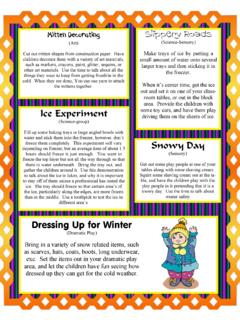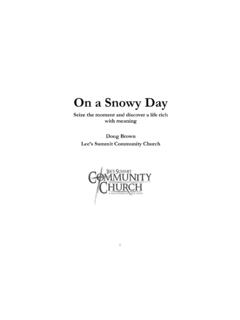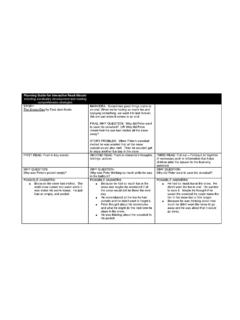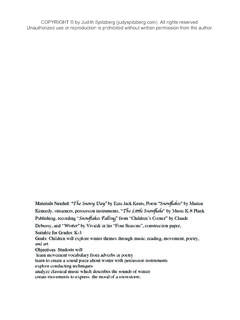Transcription of A Snowy Day - Weebly
1 VISUAL ART LESSON PLAN IRON COUNTY SCHOOL DISTRICT THE Snowy DAY: VERY COLD COLORS Grade Level:K-1 Prepared By: Alisa Petersen Fine Arts Standards 1. Use warm or cool color schemes. 2. Draw line designs. 3. Unify art by repeating elemnts Curricular Standards 4. Observe and describe typical weather for each of the seasons. 5. Perform a variety of fine motor skills ( , draw, cut, paste, mold, write). 6. Express how colors, values, and sizes have been controlled in artworks to create mood, tell stories, or celebrate events. Learning Goals: The student will .. Curriculum Tie-In Experience/Identify 1. Discuss the weather of wintertime 2. Students will identify the use of warm and cool colors in picture book illustrations. 1. Weather 2. Literacy (book) Investigate/Build Skills 1. Create six-pointed snowflakes using shapes and lines 1. Fine motor skills Vocabulary: Terms for students to learn Term Definition Warm colors Red, orange, yellow Cool colors Blue, green, purple and some pinks Introduction Procedures 1.
2 Begin with the students gathered around, sitting on the rug. Talk briefly about the seasons and specifically about winter. Then explain that you are going to read a VISUAL ART LESSON PLAN IRON COUNTY SCHOOL DISTRICT book that is all about winter. 2. Show the book, The Snowy Day, and explain that Ezra Jack Keats wrote and illustrated it. Explain that we are going to notice and talk about some choices he made while illustrating the book. 3. Show the end sheets of the book, with the snowflakes. Ask the kids what colors they see and if the page looks like a warm day or a cold day. Explain that blue, purple, green and sometimes pink are cool colors. They don t actually feel cold to the touch, but they make us think of cold things, like snow, water and ice. 4. Next see if the kids can guess that orange, red and yellow are warm colors, because they make us think of warm things like fire and the sun. 5. Ask the kids to think about Keats s color choices as you read the book.
3 6. Throughout the book, point out areas that look especially cool. Also point out Keats s deliberate use of warm colors for the snowsuit, the kitchen, and the dream of a warm sunny day. Work Procedures (Teacher) (Students) Creating, Exploration, Improvisation, Demonstration, Teacher Activities 1. Explain that we are each going to create Snowy pictures, similar to the end sheets in the book. Demonstrate how to draw snowflakes. Start with a letter X and then draw a line through it to create six points. Add embellishments like short lines, arrowheads, diamonds, squares, hearts and circles to make each snowflake unique. 2. Have students fill a page with snowflakes, using only pink, blue, purple, white and green (or leave the green off.) Have them press hard and challenge each child to try drawing with the white crayon. 3. Once the pages are full, have the students paint their entire pages with clear water, using large brushes.
4 4. When the student pages are totally wet, drop a few drops of liquid watercolor onto each paper. Allow them to push the color around with a brush, with their fingers, or by carefully tilting their pages. Encourage them to allow the paint to look watery, washed and even blotchy. 5. Allow the paper to dry completely. (Think about doing this project during the last 30 minutes of class and leave the papers on the desks overnight.) Creating, Exploration, Improvisation, Student Activities 1. Students may take turns coming to the board, showing different ways to embellish the six-pointed snowflake. 2. Explain that art is all about experimenting and trying new things and that these snowflakes are the perfect place to experiment, making each one different. 3. Allow kids to really get their pages quite wet. Explain that wet areas will look shiny and dry areas will look dull. Challenge them to fill their entire paper with water.
5 4. The kids will be excited about this part. If they choose to tilt their papers, encourage them to keep them close to the table so that the paint doesn t run right onto their laps. Also, if they rub too hard with the brush, they may make weak spots or holes in the wet paper. VISUAL ART LESSON PLAN IRON COUNTY SCHOOL DISTRICT Closure Procedures Assessment: Rubric or Questions Connect, Perceive and Assess 1. When students are finished, ask them what made the blue color slide easily around their papers (the water). 2. Ask them what would STOP the blue from sliding easily (dry areas and crayon lines). 3. Ask students to explain the meanings of warm and cool colors. 4. Students could write journal entries about colors, the process, or about winter. 1. What are the cool colors? Why do we call them cool? 2. What are the warm colors? Why do we call them warm? 3. Did students draw six pointed stars with embellishments?
6 Instructor Reflection Supplies and Resources Suggestions: What went well: What needs improvement: 1. Cool colored crayons (blues, greens, pink, white, purples) 2. Liquid watercolor in a cool color 3. White drawing paper or watercolor paper 4. The Snowy Day by Ezra Jack Keats

